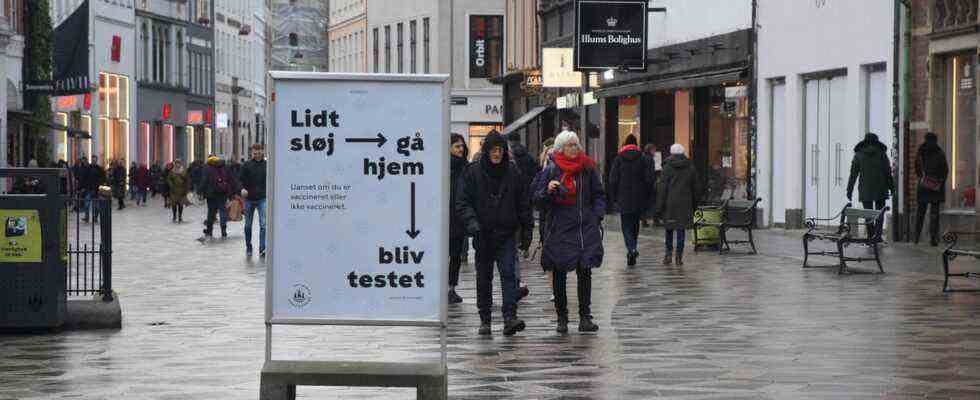Despite a seven-day incidence of more than 2000 and an omicron wave, Denmark sees itself behind the mountain. The experts in the country are optimistic. And the population is also pretty relaxed considering the high numbers.
In Germany, experts and politicians are just as afraid of an Omikron wall as many in the population. The seven-day incidence in this country is included 427.7, As of Thursday. The trend is rising, as the number of infections is increasing here. In some regions such as Hamburg, Bremen or Schleswig-Holstein the incidences are even much higher.
In Germany’s northern neighbor, the situation looks even more dramatic. But only if you look at the seven-day incidence. This is included in Denmark 2099.4.
Denmark was hit by the Omikron wave a few weeks ago. At the end of December the numbers rose dramatically again. More than 20,000 infections were registered on some days – in a population of almost six million people. The government reintroduced strict measures after the country initially lifted all measures in September and returned to normal. Mask requirements and closings of several areas were ordered again.
Corona numbers in Denmark seem to have peaked
Now the Scandinavian country wants the first corona restrictions loosen again. Cinemas and theaters are allowed to reopen, as are museums, zoos, aquariums, adult education centers and evening schools. However, mask requirements, person restrictions and the 3G rule in the form of a Corona pass apply. Discos and clubs, amusement arcades, casinos and bathing areas must remain closed until at least January 31st.
In fact, the corona numbers seem to be stagnating in the omicron wave. Data from the state health authority Statens Serum Institute (SSI) show, for example, that the number of infections is now at a stable level and even seem to be falling slightly. The number of daily hospital admissions has also remained relatively stable, as has the number of deaths.
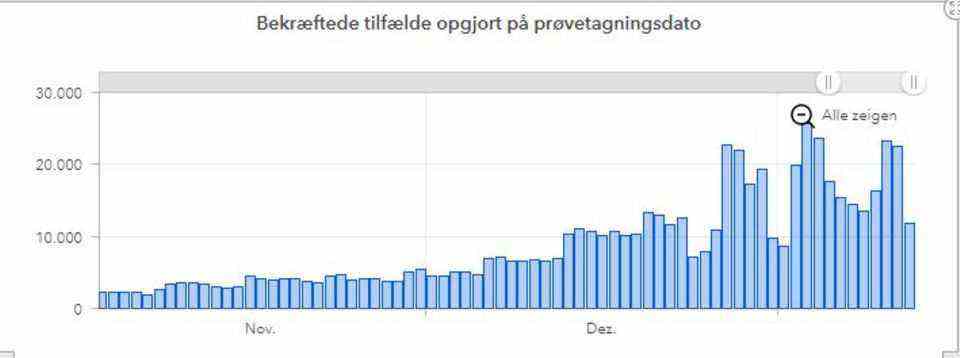
This graphic from the Statens Serum Institute (SSI) shows the registered corona infections per day (as of January 13th)
© Screenshot SSI
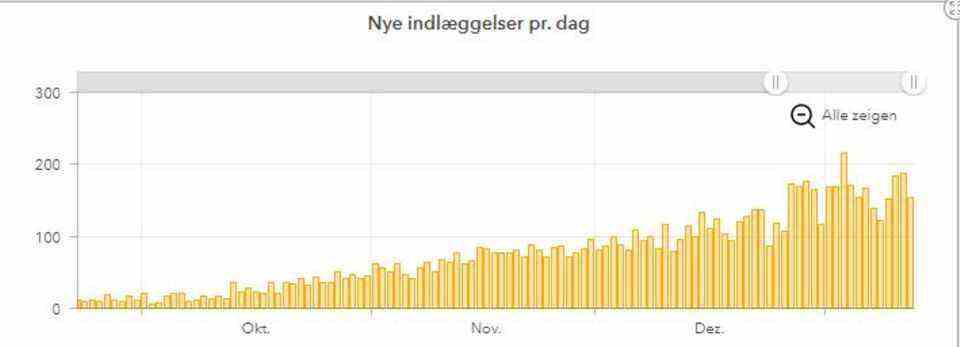
This SSI graph shows the number of new hospital admissions every day (as of January 13). The SSI does not provide figures on how many are discharged from hospitals.
© Screenshot SSI
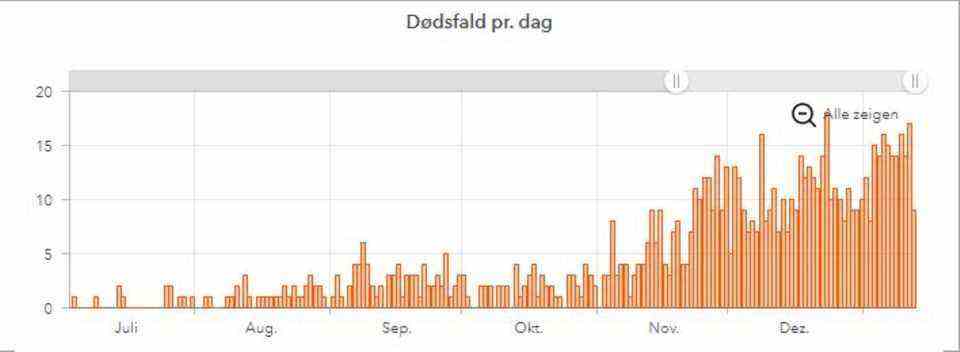
The number of dead reported daily, according to SSI (as of January 13)
© Screenshot SSI
The pressure on the hospitals is still there. But there is no overload, especially in the intensive care units. The total number of hospital admissions seems to have peaked. This was 755 on Thursday; on January 4th it was 794. And also the number of intensive care patients: inside the intensive care units, at 82 in the current wave, it seems to have peaked on Thursday a week ago. The medic Prof. Henrik Nielsen is according to the newspaper “Politics” In any case, this opinion: “We will probably have a peak here in mid-January. At least in terms of hospital stress. There are still high infection rates, and there are also many who are hospitalized. But there are just as many who are discharged.”
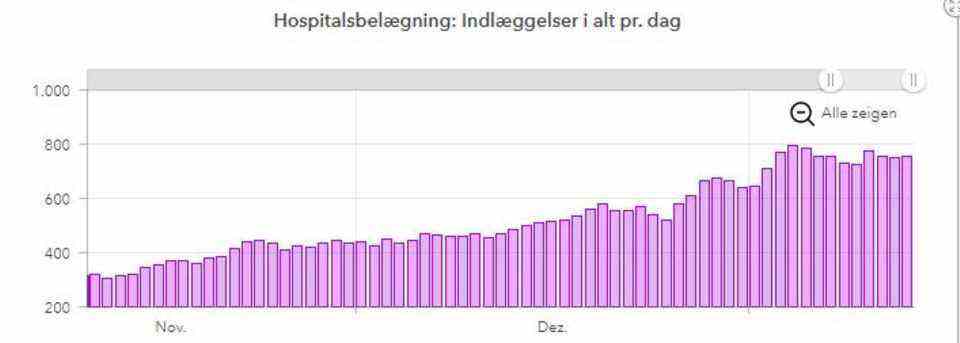
This SSI graph shows the total number of people hospitalized (as of January 13).
© Screenshot SSI

This SSI graphic shows how many people are in the intensive care units (as of January 13)
© Screenshot SSI
Vaccinations and Testing Strategy Reasons for Success
Health Minister Magnus Heunicke wrote on Twitter on Tuesday that the R value in Denmark was 1.0. “We have a stable epidemic and the contagion in society has not been followed by the same increase in hospital admissions, not even in the intensive care unit. A clear signal that Omikron is milder and that the booster is working. 54 percent of the population has been boosted. Thank you! ”
Nearly 80 percent of the Danish population is double vaccinated. In Germany the number of people vaccinated twice is only 72.3 percent. And almost 45 percent are boosted. And Denmark even wants that fourth spades to offer, but initially only for particularly vulnerable groups, such as people with a weakened immune system.
The Danish Corona Way is in the eyes Heunickes a role model worldwide, as he said at a press conference on Wednesday. “The whole world is watching. The Danish data are among the best in the world when it comes to gathering knowledge about Omikron.”
In fact, Denmark is a front runner when it comes to testing. According to SSI, almost 2.9 million corona tests were carried out in the country in the first week of the year alone – antigen and PCR tests. That is roughly half of the Danish population. Denmark is also a pioneer in sequencing the corona variants. This gives a much better overview of the pandemic situation, because the number of unreported infections is reduced. In addition, there is far advanced digitization in the country.
Experts see the end of the pandemic soon
This monitoring is one of the reasons “why we can rightly take a big step towards reopening and a more normal society,” said Heunicke.
Experts are also of the opinion that in Denmark you can slowly move towards normality. The SSI technical director Tyra Grove Krause told the television station TV2that Danish society is moving into a state of affairs that is comparable to flu waves, despite high omicron numbers. “It is true that we are moving a little more towards such a flu-like pattern, where the strategy is the same. We cannot prevent contagion in the population, but we can ensure that the most vulnerable are protected from serious illnesses. “
According to Krause, the state’s vaccination strategy should in future be similar to that of the common flu variants against which the older part of the population is also vaccinated. “Nursing home residents and the elderly need to be offered an extra dose of vaccine. It is a group of citizens most at risk of becoming seriously ill. It is really important to make sure that this group is particularly well protected.”

At the beginning of January, Tyra Grove Krause expressed the optimistic hope that Denmark will reach the peak of the omicron wave at the end of January and return to a “normal state” after about two months with decreasing numbers of infections.
“Not as bad as it could have been”
The pandemic researcher Lone Simonsen also sees an end to the pandemic after Omikron, as it is the public broadcasting Danmarks Radio (DR) said: “Now we’re getting a mighty wave of omicrons that will drop sometime in February or March. Then come spring and summer and we’re used to it being much better with viruses. Then comes autumn, and that’s where we think we are I finished the pandemic phase. “
The variant has been shown to be milder than Delta and the vaccines are very effective against hospital admissions and deaths. “So it’s not as bad as it could have been,” said Simonsen. She reckons that there will be milder “winter epidemics” in the future, in which the risk groups will have to be vaccinated against the current variant of the coronavirus.
Søren Riis Paludan, a virologist at the University of Aarhus, is similarly optimistic: “Since many people become infected with Omikron and we thereby gain more immunity in society, there will be fewer seriously ill. When we get to spring, my prognosis is, that the pandemic is over. ” According to the scientist, the vaccine and previous infections give you a very high level of immunity. “The omicron variant, and likely future variants, are less pathogenic. There is no reason to believe that future variants will be more serious.”
Danes are no longer so worried about Corona
The optimism of the experts also carries over to the population. Investigations of the HOPE project, which tracks the behavior and reactions of Danes during the corona pandemic, has come to the conclusion that Danes are less afraid of a corona infection. In the past one would have looked closely at the infection numbers, today it is the hospitalization values, says the head of the project, Michael Bang Petersen, to DR.
“If a year ago we had 22,000 infected people every day, all the alarm bells would have rang, but not to the same extent today,” says Petersen. The new figures from the HOPE project show that Danes generally accept high infection rates as long as they do not overload the hospitals. And that won’t be the case, says Anders Perner, professor and doctor at Rigshospitalet in Copenhagen. “It is very unlikely that the Omikron variant will present us with any major challenges in the intensive care units,” he told DR.

